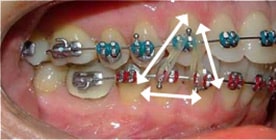
by Dr. Greg Greenberg
An elastic is essentially a small rubber band that your orthodontist will tell you to attach to your braces in a certain configuration/shape. The purpose of an elastic is to allow the patient to assist the orthodontist in the movement of their teeth. Braces often times may not be able to move teeth exactly where the orthodontist would like, thus elastics help with that movement.
Material of Elastics
Elastics are made of either latex or a non-latex material. Latex is the most commonly used material in elastics; however, if the patient is allergic to latex, then a non-latex kind can be used. Research has shown that latex elastics remain stronger after wear for 24 hours. Some elastics even glow in the dark!
Size and Strength of Elastics
If you read the package of elastics that you are given, there are three important parts to the elastic identification: 1) diameter 2) strength 3) name. The diameter is essentially the width of the elastic expressed as a fraction of an inch. Smaller diameters elastics are used for attaching to teeth with short distances apart and vice versa for long distances. The strength of the elastic is essentially how strong it is. The strength is expressed in ounces and stronger forces are needed when stronger wires are being used (i.e., steel). The name of the elastic helps the patient identify which elastic they are using. Each orthodontic company has their own names for rubber bands (i.e., boy/girl names, animals, countries, etc.)
You should not buy elastics on your own from the internet. Not all elastics are equivalent and may change your treatment if used improperly! You should only get your elastics from your orthodontist, and use them as directed.
Configuration of Elastics
Depending on how your orthodontist wants your teeth to move, they will tell you to attach your elastics to certain teeth to help accomplish that movement. Here are some common configurations of rubber bands:

Class II elastic – These elastic usually attach from the upper canine hook to either the bottom 1st molar hook or 2nd molar hook. These elastics help move your upper teeth back and your bottom teeth forward.

Triangle Class II elastic– Like the Class II elastic, this elastic starts from the upper canine hook. It also attaches to a bottom bicuspid hook along with the bottom 1st molar or 2nd molar hook forming a triangle. This helps move your upper teeth back and bottom teeth forward and also helps bring the back teeth together and touching.

Class III elastic – This elastic starts from the bottom canine and goes to the upper 1st molar or 2nd molar. This moves your upper teeth forwards and bottom teeth back. This is the opposite movement from a Class II elastic.

Triangle Class III elastic – Like the Class III elastic, this elastic starts from the bottom canine hook. It also attaches to a upper bicuspid hook along with the upper 1st molar or 2nd molar hook forming a triangle. This helps move your upper teeth forward and bottom teeth back and also helps bring the back teeth together and touching.

Class I elastic – These elastics run from the upper 1st or 2nd molar hook to the upper canine hook. These push teeth together to help close any gaps between the teeth. It can be also used on the bottom teeth.

Box elastic – the elastic is attached to four teeth: two on the upper and two on the bottom forming the shape of a box. Can be attached to any configuration of teeth but are most commonly used on the back teeth. This helps to bring the teeth together and touching.


V elastics – these elastics attach to three teeth and form the shape of a V. These elastics help bring teeth together and touching. They can be used on front teeth or back teeth.

Anterior triangle elastic –These elastics usually run from the upper canine hook to the bottom canine and bottom 1st premolar hooks forming the shape of a triangle. This helps in open bite situations where your top front teeth don’t touch the bottom front teeth.

Crossbite elastic – These elastics usually run from the inside of an upper tooth to the outside of a bottom tooth to help correct a crossbite (a situation where your upper teeth are inside your bottom teeth).

Midline elastic – This elastic can run from the upper canine hook to the bottom canine hook, but it can also be attached to other front teeth. This helps line up the center of the upper and bottom front teeth.
Elastic Wear
Normally you will wear the elastics all the time except eating and brushing. In order to get teeth to move properly, elastics have to be worn full time. Think of wearing elastics like pushing a car up a hill. The more you wear your elastics, the further you push the car up the hill. Anytime you stop wearing elastics, the car will roll back down the hill and you have to start all over again. If you don’t wear your elastics all the time, your teeth will shift back to their original position. In certain situations, your orthodontist may only require you to wear elastics at night.
Every time you eat or brush your teeth, replace the old elastic with a new one. Elastics lose strength over time and thus you need a new one to keep constant force on the teeth to move them. If the rubber bands snap or break, then replace them with a new one.
Which elastics will work?
Only your orthodontist can determine the appropriate length and strength of elastic that needs to be used in your specific case. Once you are given a specific kind, be sure to use only that kind of elastic. Don’t try to wear double the amount of elastics because it could actually have harmful effects on teeth.
 Dr. Greg Greenberg received his Bachelors degree from Tulane University in New Orleans, Louisiana. Following undergraduate school, Dr. Greenberg attended Baylor College of Dentistry in Dallas, Texas and received his Doctorate of Dental Surgery. Dr. Greenberg then attended Columbia University in New York, New York for his certificate in orthodontics.
Dr. Greg Greenberg received his Bachelors degree from Tulane University in New Orleans, Louisiana. Following undergraduate school, Dr. Greenberg attended Baylor College of Dentistry in Dallas, Texas and received his Doctorate of Dental Surgery. Dr. Greenberg then attended Columbia University in New York, New York for his certificate in orthodontics.
For over 20 years, Dr. Greenberg has been building beautiful smiles in the Dallas and Frisco areas of Texas. He is an Invisalign Premier Provider and is a member of the Greater Dallas Association of Orthodontists, American Association of Orthodontists, American Dental Association, Texas Dental Association, Southwestern Society of Orthodontists, and the Dallas County Dental Society. His website is: //www.rxsmile.com/

